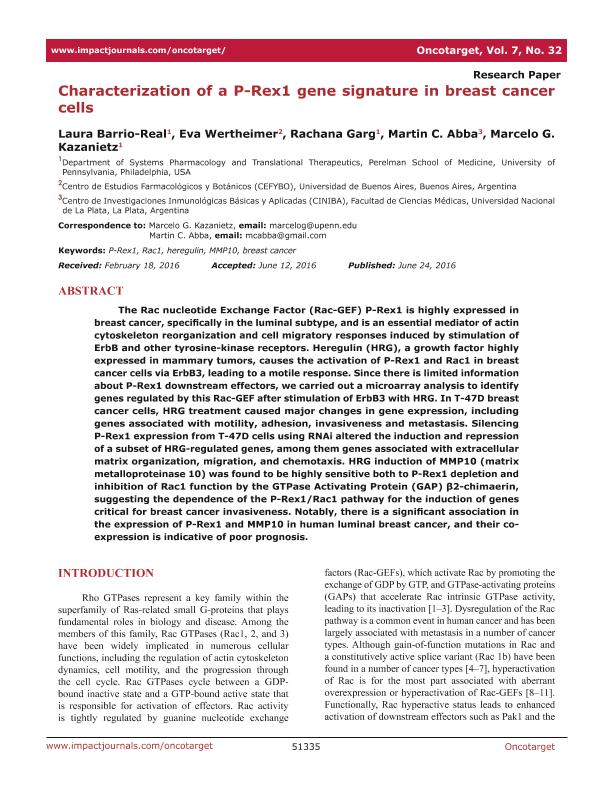Artículo
Characterization of a P-Rex1 gene signature in breast cancer cells
Barrio Real, Laura; Wertheimer Hermitte, Eva Victoria ; Garg, Rachana; Abba, Martín Carlos
; Garg, Rachana; Abba, Martín Carlos ; Kazanietz, Marcelo Gabriel
; Kazanietz, Marcelo Gabriel
 ; Garg, Rachana; Abba, Martín Carlos
; Garg, Rachana; Abba, Martín Carlos ; Kazanietz, Marcelo Gabriel
; Kazanietz, Marcelo Gabriel
Fecha de publicación:
06/2016
Editorial:
Impact journals
Revista:
Oncotarget
e-ISSN:
1949-2553
Idioma:
Inglés
Tipo de recurso:
Artículo publicado
Clasificación temática:
Resumen
The Rac nucleotide Exchange Factor (Rac-GEF) P-Rex1 is highly expressed in breast cancer, specifically in the luminal subtype, and is an essential mediator of actin cytoskeleton reorganization and cell migratory responses induced by stimulation of ErbB and other tyrosine-kinase receptors. Heregulin (HRG), a growth factor highly expressed in mammary tumors, causes the activation of P-Rex1 and Rac1 in breast cancer cells via ErbB3, leading to a motile response. Since there is limited information about P-Rex1 downstream effectors, we carried out a microarray analysis to identify genes regulated by this Rac-GEF after stimulation of ErbB3 with HRG. In T-47D breast cancer cells, HRG treatment caused major changes in gene expression, including genes associated with motility, adhesion, invasiveness and metastasis. Silencing P-Rex1 expression from T-47D cells using RNAi altered the induction and repression of a subset of HRG-regulated genes, among them genes associated with extracellular matrix organization, migration, and chemotaxis. HRG induction of MMP10 (matrix metalloproteinase 10) was found to be highly sensitive both to P-Rex1 depletion and inhibition of Rac1 function by the GTPase Activating Protein (GAP) β2-chimaerin, suggesting the dependence of the P-Rex1/Rac1 pathway for the induction of genes critical for breast cancer invasiveness. Notably, there is a significant association in the expression of P-Rex1 and MMP10 in human luminal breast cancer, and their co-expression is indicative of poor prognosis.
Palabras clave:
Prex1
,
Rac1
,
Heregulin
,
Brest Cancer
,
Mmp10
Archivos asociados
Licencia
Identificadores
Colecciones
Articulos(CEFYBO)
Articulos de CENTRO DE ESTUDIOS FARMACOLOGICOS Y BOTANICOS
Articulos de CENTRO DE ESTUDIOS FARMACOLOGICOS Y BOTANICOS
Citación
Barrio Real, Laura; Wertheimer Hermitte, Eva Victoria; Garg, Rachana; Abba, Martín Carlos; Kazanietz, Marcelo Gabriel; Characterization of a P-Rex1 gene signature in breast cancer cells; Impact journals; Oncotarget; 7; 32; 6-2016; 51335-51348
Compartir
Altmétricas



